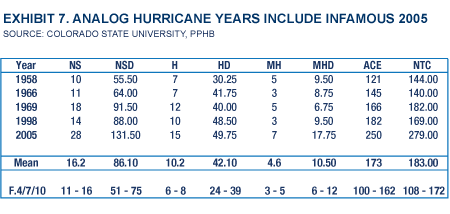Musings: Gas Prices Reflect Little Worry over Hurricane Forecast
Last week's price action of natural gas futures suggested there is little concern among buyers about the potential for a more active hurricane season disrupting available gas supply from the Gulf of Mexico. Gas prices bounced around the $4 per Mcf level most of the week, responding to news about the upcoming revision to the EIA's 914 survey of domestic gas production and gas storage inventory data rather than recognition that the latest Colorado State University (CSU) hurricane forecasting team had boosted their estimate of the number of tropical storms, hurricanes and major hurricanes.
There is little concern among gas buyers about the potential for a more active hurricane season disrupting available gas supply from the Gulf of Mexico
In its traditional early spring forecast revision, the hurricane forecasting team, led by Professors Philip Klotzbach and William Gray of the Department of Atmospheric Science at CSU, lifted its forecast for the number of tropical storms, hurricanes, major hurricanes and storm days in each category that can be expected this hurricane season into the upper end of its earlier December 9th forecasted ranges. The forecasting team now expects 15 named storms, eight hurricanes and four major hurricanes. If the forecast materializes, this year's storm season will resemble the hurricane seasons of 2003, 2004, 2005 and 2008. As we know, those years included some of the worst hurricanes to hit the Gulf Coast and Southeast United States in recent years -- Katrina, Rita, Ike, Ivan and Isabelle to name a few.

To reinforce the potential for a significantly more active and potentially destructive storm season, the CSU team provided its estimates for hurricane landfalls. The CSU team predicts that a major hurricane has a 45% chance of hitting somewhere along the U.S. East Coast including the Florida peninsula, which compares to a 31% average for the last century. The probability of a major hurricane landing somewhere along the Gulf Coast extending from the Florida Panhandle westward to Brownsville, Texas at the Mexican/U.S. border is estimated at 44% compared to 30% for the past 100 years. These forecast percentages clearly suggest the Gulf Coast and U.S. East Coast need to be alert this coming storm season. The forecast suggests possible energy supply problems this summer and fall for the U.S. How severe those problems might be are impossible to know at the current time, but recent history suggests there could be significant problems.
These forecast percentages clearly suggest the Gulf Coast and U.S. East Coast need to be alert this coming storm season
Just how bad things could become needs to be analyzed in the context of recent past experience, but importantly the repairs and altered operating policies due to past storm damage may mitigate the problem. Additionally, the emergence of substantial and growing natural gas production from onshore gas shales has reduced some of the energy supply risk from storm-induced lost production from the Gulf of Mexico.
The emergence of substantial and growing natural gas production from onshore gas shales has reduced some of the energy supply risk
It is interesting that the CSU forecast team has included 2005 as an analog year in preparing their forecast. That was the infamous year that produced hurricanes Katrina that destroyed New Orleans and the Mississippi Gulf Coast and Rita that hit the Upper Texas Gulf Coast and southwestern Louisiana. Both of these storms caused extensive damage to the offshore oil and gas industry infrastructure disrupting both onshore and offshore gas drilling, production and transportation along with refinery operations in the region.

As usual Dr. Gray also took on the issue of the role of global warming and Atlantic basin hurricane activity. He continues to produce data that undercuts the argument for rising CO2 being the cause of increased frequency and intensity of hurricanes. He also attacks the theoretical rationale for that argument. We will review this analysis in the next Musings as we find it interesting, cogent and important to understand given the upcoming energy and climate change legislation debate in the next several months.
Managing Director, PPHB LP
- How Likely Is an All-Out War in the Middle East Involving the USA?
- Rooftop Solar Now 4th Largest Source of Electricity in Australia
- EU, Industry Players Ink Charter to Meet Solar Energy Targets
- US Confirms Reimposition of Oil Sanctions against Venezuela
- Analyst Says USA Influence on Middle East Seems to be Fading
- Brazil Court Reinstates Petrobras Chair to Divided Board
- Russian Ships to Remain Banned from US Ports
- EIB Lends $425.7 Million for Thuringia's Grid Upgrades
- Var Energi Confirms Oil Discovery in Ringhorne
- Seatrium, Shell Strengthen Floating Production Systems Collaboration
- An Already Bad Situation in the Red Sea Just Got Worse
- What's Next for Oil? Analysts Weigh In After Iran's Attack
- USA Regional Banks Dramatically Step Up Loans to Oil and Gas
- EIA Raises WTI Oil Price Forecasts
- Venezuela Authorities Arrest Two Senior Energy Officials
- Namibia Expects FID on Potential Major Oil Discovery by Yearend
- How Likely Is an All-Out War in the Middle East Involving the USA?
- Oil Markets Were Already Positioned for Iran Attack
- Is The Iran Nuclear Deal Revival Project Dead?
- Petrobras Chairman Suspended
- Oil and Gas Executives Predict WTI Oil Price
- An Already Bad Situation in the Red Sea Just Got Worse
- New China Climate Chief Says Fossil Fuels Must Keep a Role
- Oil and Gas Execs Reveal Where They See Henry Hub Price Heading
- Equinor Makes Discovery in North Sea
- Macquarie Strategists Warn of Large Oil Price Correction
- DOI Announces Proposal for Second GOM Offshore Wind Auction
- Standard Chartered Reiterates $94 Brent Call
- Chevron, Hess Confident Embattled Merger Will Close Mid-2024
- Analysts Flag 'Remarkable Feature' of 2024 Oil Price Rally


